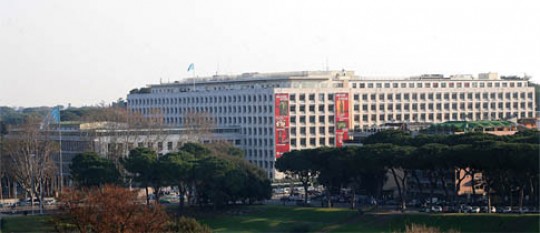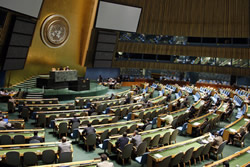Efficiency of livestock systems must be improved – UN report
Efficiency of livestock systems must be improved – UN report
 Zebu cattle on a breeding farm in Kenya
Zebu cattle on a breeding farm in Kenya
As demand for livestock increases, efficient methods to increase production will be crucial to meet global needs, a new United Nations report stresses, warning current production practices lack the necessary capabilities to provide sustainable solutions over the next few decades.
“As it stands, there are no technically or economically viable alternatives to intensive production for providing the bulk of the livestock food supply for growing cities,” says the World Livestock 2011 report, released today by the Food and Agriculture Organization (FAO).
According to the report, by 2050 consumption of animal protein will increase by two thirds, particularly in developing countries, bringing new strains on the planet’s natural resources.
An urgent challenge is to make intensive production more environmentally benign.
Much of the demand will be met by large-scale, intensive animal-rearing operations. However, the report warns that large-scale production is a source of concern due to negative environmental impacts such as groundwater pollution and greenhouse gas (GHG) emissions, as well as their potential to act as disease incubators.
Rather than increasing production, the report argues that improvements in the efficiency of current livestock systems will be needed, which will require capital investment and supporting policies.
“An urgent challenge is to make intensive production more environmentally benign,” the report says, and provides three ways to achieve this, which include reducing the level of pollution generated from waste and GHGs, reducing the input of water and grain needed for each output of livestock protein, and recycling agro-industrial by-products through livestock populations.
The report stresses that one of the main challenges the industry faces is keeping livestock healthy as production is ramped up, as diseases may directly threaten human health.
“It is not enough to pour funding into coping with the urgent disease threats of today – disease intelligence and epidemiological research must be financed to anticipate future diseases in the countries that produce the bulk of livestock source food,” it says.
Animal protein products today make up 12.9 per cent of calories consumed worldwide, amounting to 20.3 per cent in developed countries.
However, the report says consumption has not increased evenly around the world. In developing countries, particularly in sub-Saharan Africa, many communities have not seen an increase in their animal protein consumption, the report says.
“Average consumption of livestock protein in Africa is less than a quarter of that in the Americas, Europe and Oceania, and represents just 17 per cent of the recommended consumption level for all proteins,” says the report. “By contrast, the consumption of livestock protein in the Americas, Europe and Oceania in 2005 was between 78 and 98 per cent of the total protein requirement, suggesting that livestock products are being over-consumed.”
The report adds that an increase in livestock consumption in developing countries is needed as it can have significant effects combating malnourishment.
###
> UN Food and Agriculture Organization (FAO).
The Food and Agriculture Organization of the United Nations (FAO) is an intergovernmental organization and has 191 Member Nations, two associate members and one member organization, the European Union. Achieving food security for all is at the heart of FAO’s efforts – to make sure people have regular access to enough high-quality food to lead active, healthy lives.

FAO’s mandate is to raise levels of nutrition, improve agricultural productivity, better the lives of rural populations and contribute to the growth of the world economy.
The Food and Agriculture Organization of the United Nations (FAO) is working with its Members and the entire international community for achievement of the Millennium Development Goals.
These eight goals – each with specific targets and indicators – are based on the United Nations Millennium Declaration, signed by world leaders in September 2000. They commit the international community to combating poverty, hunger, disease, illiteracy, environmental degradation, and discrimination against women.
![]()
The eight Millennium Development Goals are:
Goal 1: Eradicate extreme poverty and hunger
Goal 2: Achieve universal primary education
Goal 3: Promote gender equality and empower women
Goal 4: Reduce child mortality
Goal 5: Improve maternal health
Goal 6: Combat HIV/AIDS, malaria and other diseases
Goal 7: Ensure environmental sustainability
Goal 8: Develop a Global Partnership for Development
* More information at UN Food and Agriculture Organization (FAO)
###
> United Nations (UN).
 The United Nations was established on 24 October 1945 by 51 countries committed to preserving peace through international cooperation and collective security. Today, nearly every nation in the world belongs to the UN: membership totals 192 countries.
The United Nations was established on 24 October 1945 by 51 countries committed to preserving peace through international cooperation and collective security. Today, nearly every nation in the world belongs to the UN: membership totals 192 countries.
When States become Members of the United Nations, they agree to accept the obligations of the UN Charter, an international treaty that sets out basic principles of international relations. According to the Charter, the UN has four purposes:
- to maintain international peace and security;
- to develop friendly relations among nations;
- to cooperate in solving international problems and in promoting respect for human rights;
- and to be a centre for harmonizing the actions of nations.
###
* The above story is adapted from materials provided by United Nations (UN)
** More information at United Nations (UN)





















